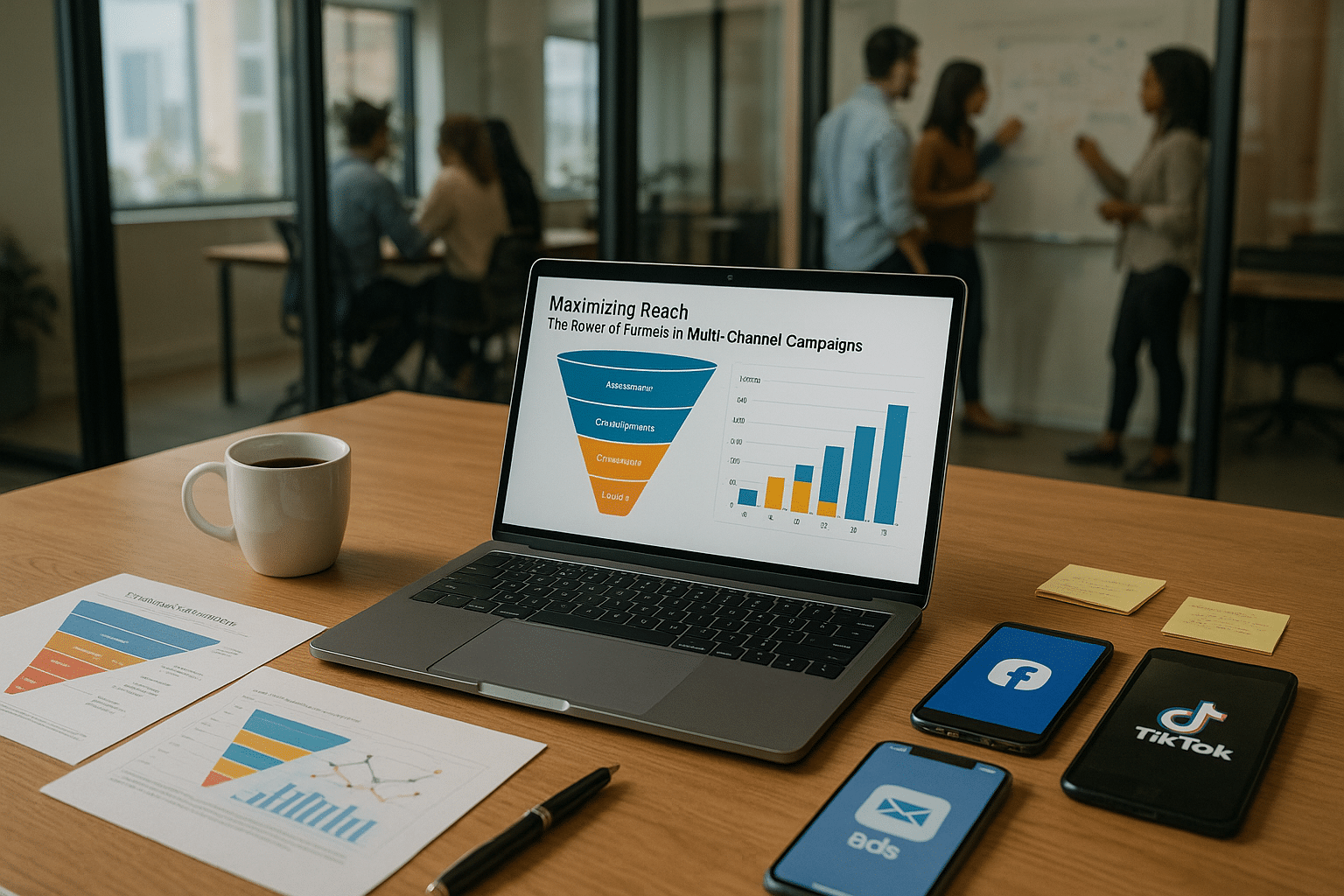But how exactly do they intersect and what kind of power do they hold in maximizing reach? Let’s unravel this intertwined mystery together.
Imagine your business as a vast ocean 🌊, the potential customers as fishes 🐠, and your marketing tactics as the net. To catch as many fishes as possible, you need not only a vast and robust net but also the skill to cast it across various corners of the ocean, effectively and strategically. This is where the concept of multi-channel campaigns comes into play. It’s about spreading your net across multiple platforms – be it social media, email, content marketing, or even traditional advertising channels.
Now, imagine if you could optimize this net to work even more efficiently? To not just spread wide but also to guide the fishes towards a specific point? Yes, this is where funnels come into the picture. The essence of a marketing funnel is to attract potential customers, nurture them, and gradually guide them towards a specific action – usually a purchase. It’s like a step-by-step guide for your customers, leading them through the buyer’s journey.
But the question is – how to blend the wide reach of multi-channel campaigns with the focused approach of a funnel? That’s exactly what we’ll be exploring in this article! Here’s a sneak peek into the key topics we’ll be covering:
Understanding the Power of Funnels and Multi-Channel Campaigns
The power of funnels in multi-channel campaigns is a topic that deserves a deep dive. We will walk you through the various stages of a marketing funnel and how they can be applied to different channels to maximize reach.
Strategies to Maximize Reach with Funnels in Multi-Channel Campaigns
As we delve deeper, we will discuss the tactics to supercharge your multi-channel campaign with a funnel strategy. How to guide your audience from one stage to the next? How to make sure your efforts on one channel complement those on another? Brace yourself for some actionable insights.
Case Studies and Real-Life Examples
Words are powerful, but actions speak louder. To provide a practical perspective, we will explore some successful real-life examples and case studies of businesses that have leveraged the power of funnels in multi-channel campaigns.
Whether you’re a seasoned marketer, a budding entrepreneur, or anyone interested in digital marketing strategies, this comprehensive guide will serve as a roadmap to help you navigate the landscape of multi-channel campaigns and funnels. So, are you ready to dive in and maximize your reach? Let’s go! 🚀
🔍 Understanding Multi-Channel Campaigns and Funnels
As digital marketing landscapes evolve, multi-channel campaigns have become a fundamental aspect of a successful marketing strategy. These campaigns leverage various platforms to reach a wider audience and generate leads, sales, and conversions. But without a well-designed marketing funnel, it’s challenging to maximize the potential of multi-channel campaigns.
A marketing funnel is a visual representation of the customer journey, from the awareness stage to the purchase stage. It helps businesses identify and address gaps in their marketing strategies. But how do these funnels work in a multi-channel campaign? Let’s delve into that.
To paint a clear picture, imagine you’re running an ad campaign on Google, Facebook, and Instagram simultaneously. Without a funnel, you’ll be unable to track which platform is generating the most leads and, consequently, optimize your campaign for better results. With a marketing funnel, however, you can easily identify successful channels and refine your approach accordingly.
📈 The Role of Funnels in Multi-Channel Campaigns
Funnels play a crucial role in multi-channel campaigns. They help businesses identify the platforms that generate the most customer engagement, leads, and sales. This enables marketers to allocate resources more efficiently and design more effective strategies.
🎯 Maximizing Reach: Power of Funnels in Multi-Channel Campaigns
The power of funnels in multi-channel campaigns lies in their ability to track and analyze user behavior across different platforms. This data-driven approach allows marketers to optimize their strategies based on insights gleaned from the funnel.
For instance, if your funnel shows that Facebook ads are driving more conversions than Instagram ads, you can allocate more resources to the former to maximize results. Similarly, if your Google ads are not generating enough leads, you can tweak your strategy or focus on other platforms.
By helping marketers identify the best-performing channels, funnels contribute to a more efficient and effective multi-channel campaign. In this way, funnels empower businesses to maximize their reach and achieve their marketing goals.
📚 Case Study: How Funnels Power Multi-Channel Campaigns
To better understand the power of funnels in multi-channel campaigns, let’s consider a case study of an e-commerce business that used a marketing funnel to maximize its multi-channel campaign.
The business used Google, Facebook, and Instagram ads to promote its products. After analyzing its funnel, the business realized that Facebook ads were driving the most conversions, while Google ads were generating the least leads. Accordingly, the business decided to allocate more resources to Facebook ads and rethink its Google ad strategy.
After making these adjustments, the business saw a significant increase in conversions and sales, demonstrating the power of funnels in multi-channel campaigns.
📊 Comparing Funnels Across Different Platforms
Let’s take a closer look at how funnels perform across different platforms. The table below provides a comparative analysis.
| Platform | Top of the Funnel | Middle of the Funnel | Bottom of the Funnel |
| High | Medium | High | |
| High | High | Medium | |
| Medium | Low | High |
As evident from the table, different platforms perform differently at various stages of the funnel. This highlights the need for a well-structured funnel to guide your multi-channel campaign.
Related video: “Maximizing Your Reach: The Power of Funnels in Multi-Channel Campaigns” by Neil Patel. This informative video provides insights into maximizing the impact of your multi-channel campaigns using funnels.
🧩 Constructing an Effective Funnel for Your Multi-Channel Campaign
Creating an effective funnel for your multi-channel campaign involves several steps. Here are some key steps to consider:
- Identify your target audience: Understanding your audience’s needs and preferences is crucial in building an effective funnel.
- Define your marketing goals: Whether it’s increasing brand awareness, generating leads, or driving sales, clear goals help shape your funnel and determine the success of your campaign.
- Choose your platforms: Select the channels that best reach your target audience. This could be social media, email marketing, search engine marketing, or a combination of these.
- Design your funnel: Map out the customer journey from the awareness stage to the conversion stage. This should include touchpoints across all chosen platforms.
- Analyze and optimize: Once your campaign is live, analyze the performance of your funnel and make necessary adjustments.
An effective funnel can significantly enhance the success of your multi-channel campaign by enabling you to reach more people, generate more leads, and ultimately, drive more conversions.

Conclusion
As we draw to a close on this exhaustive discussion of software engineering, it is important to highlight the key elements we have covered. To begin with, we delved deep into the core fundamentals of software engineering, unraveling the intricate details that underpin the development of powerful, high-performance software solutions. 📘💻
From the critical role of system analysis in the early stages, to the complexities of system design and the rigorous approach needed in the coding phase, we have journeyed through the entire software engineering life cycle. Not forgetting the importance of rigorous testing and maintenance to ensure software reliability and longevity.
Throughout this journey, we have seen the immense importance of software engineering in today’s digital age. Without it, the technology-driven world we live in would simply not be possible. Whether it’s the apps on your smartphone, the software in your car, or the systems that power businesses and governments around the world, software engineering plays a pivotal role. 🌐💼
We also looked at the various software engineering methodologies and how they contribute to project success. From the traditional waterfall model, to the more modern agile and DevOps approaches, we uncovered how different methodologies suit different project requirements and contexts.
Next, we touched on the significance of good documentation in software engineering. A well-documented software can make a world of difference, making it easier for other developers to understand and modify the system, thus improving efficiency and productivity. 👨💻📝
I hope that this exploration of software engineering has not only enhanced your technical understanding but also inspired you to dig deeper into this fascinating field. If you’ve found this article valuable, feel free to share it with your colleagues and peers. Don’t forget to leave a comment below if you have any questions or thoughts to share – I would love to hear from you. 😊👇
To learn more, check out the following resources that provide a wealth of information on software engineering:
1. IEEE Computer Society – Technical Committee on Software Engineering
2. ACM SIGSOFT – The Association for Computing Machinery’s Special Interest Group on Software Engineering
3. IEEE Transactions on Software Engineering
Remember, the field of software engineering is vast and ever-evolving. It demands continuous learning and adaptation. So, keep exploring, keep learning, and keep pushing the boundaries of what’s possible with software engineering.
Finally, if you’re ready to implement what you’ve learned or share your thoughts on this complex subject, don’t hesitate! Your contribution could spark a new idea, improve a process, or simply help someone understand a complex concept. Let’s keep the conversation going! 🚀🗣️
References
1. IEEE Computer Society – Technical Committee on Software Engineering
2. ACM SIGSOFT – The Association for Computing Machinery’s Special Interest Group on Software Engineering
3. IEEE Transactions on Software Engineering
Your companion in software engineering exploration,
Rodrigo Almeida 👋



